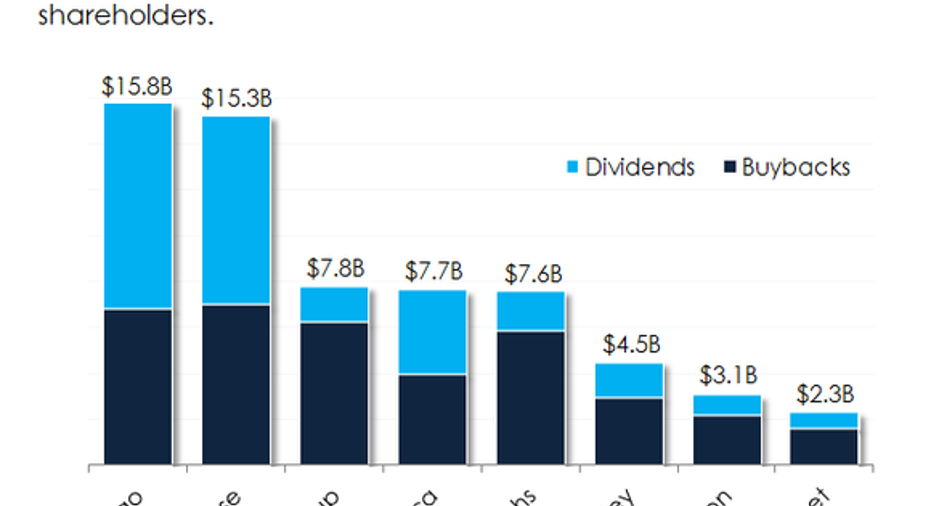These Bank Stocks Are Making It Rain for Shareholders

When it comes to dividends and stock buybacks, these two banks make it rain. Image source: iStock/Thinkstock.
One reason investors have long had a penchant for bank stocks is because they tend to pay generous dividends. But quarterly distributions are only half the story when it comes to rewarding shareholders. To get a true sense of how much capital a bank returns to its shareholders, you also have to factor in stock buybacks.
If you combine the amount of money that the nation's biggest banks pay out to shareholders through both of these methods, two bank stocks separate themselves from the pack: Wells Fargo (NYSE: WFC) and JPMorgan Chase (NYSE: JPM). Over the past 12 months, these banks distributed nearly twice as much capital as third- and fourth-place finishers Citigroup (NYSE: C) and Bank of America (NYSE: BAC).
Data source: YCharts.com. Chart by author.
There are three reasons that Wells Fargo and JPMorgan Chase are in a league of their own when it comes to returning capital, the first of which relates to their size.
JPMorgan Chase is the biggest bank in the country. At the end of the second quarter, the New York City-based bank had $2.5 trillion worth of assets on its balance sheet. And if you include assets that it administers but are owned by clients -- namely, assets under management or custody -- then its size balloons to nearly $25 trillion.
Wells Fargo, by contrast, ranks third, with $1.9 trillion worth of assets on its balance sheet. This is smaller than Bank of America, which has $2.2 trillion in assets, but Wells Fargo is gaining quickly on its larger rival. It eclipsed Citigroup last year to lay claim to the No. 3 spot, and at Wells Fargo's current rate of growth, it could do the same to Bank of America in the near future.
The second reason that Wells Fargo and JPMorgan Chase distribute so much capital to shareholders is because they earn a lot of money. Wells Fargo reported $22.4 billion in net income over the past 12 months, according to data from YCharts.com, while JPMorgan Chase earned an even more impressive $23.9 billion.
They have little choice but to pay out a lot of capital, in other words, to ensure that it doesn't build up on their balance sheets and thereby weigh down their return on equity, which is the primary profitability metric tracked by bank stock investors. This helps to explain why Bank of America and Citigroup trade for such low valuations, as their less-generous dividend and buyback programs have swelled their respective shareholders' equities.
The final reason that Wells Fargo and JPMorgan Chase pay out so much more than their counterparts is because they can. Under the Dodd-Frank Act, which was passed in the wake of the financial crisis, the Federal Reserve gained veto power over bank capital plans. Now, if a bank wants to boost its dividend or its repurchase authorization, it must request the Fed's permission in the comprehensive capital analysis and review (CCAR), the second stage of the annual stress tests.
This is inconvenient, but it hasn't stopped Wells Fargo or JPMorgan Chase from raising their dividends every year since 2011. Bank of America and Citigroup, by contrast, haven't been as fortunate. Both have had their capital proposals rejected by the central bank multiple times since the stress tests were inaugurated six years ago. The net result is that they've been allowed to boost their dividends only twice each since the crisis, most recently this year.
In sum, if you're looking for bank stocks that return the most capital to shareholders, then the obvious place to start is by going with the biggest and best banks in the country: Wells Fargo and JPMorgan Chase.
A secret billion-dollar stock opportunity The world's biggest tech company forgot to show you something, but a few Wall Street analysts and the Fool didn't miss a beat: There's a small company that's powering their brand-new gadgets and the coming revolution in technology. And we think its stock price has nearly unlimited room to run for early in-the-know investors! To be one of them, just click here.
John Maxfield owns shares of Bank of America, Wells Fargo, and Goldman Sachs. The Motley Fool owns shares of and recommends Wells Fargo. The Motley Fool recommends Bank of America. Try any of our Foolish newsletter services free for 30 days. We Fools may not all hold the same opinions, but we all believe that considering a diverse range of insights makes us better investors. The Motley Fool has a disclosure policy.